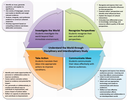Your browser does not support viewing this document. Click here to download the document.
In My Own Words.... Definitions of Terms:
- Global citizenship: recognition of one's role in the larger world. The ability to act locally and think globally. Having a sense of social responsibility on a global scale.
- Global perspectives: viewpoints that consider thoughtfully cultural similarities and differences across nations, regions, race, socio-economics, etc.
- Cross Cultural Education: a system of teaching and learning that attempts to create bridges between cultures to better understand and explore diverse ways of thinking and problem solving while honoring cultural differences and perspectives.
- Global competencies: a developed skill set for interacting with a variety of people from diverse backgrounds. Abilities to see the "bigger picture" and use new perspectives to engage in a global and connected world.
- Trans-Nationalism: the connection of people across countries.
- Cosmopolitanism: theory that we are all one big community (world-wide), and that we can develop common social standards and sets of morals and morès.
- Transferability: referring to whether a concept or custom can be "transferred" across cultures. For example, can what works for people in remote regions also work for people in urban areas? Can we adapt to each other's cultural standards or adapt to them if necessary?
- Globalization: the ongoing process of connecting more and more of the world through travel, technology, business, and education.
- College & Career Readiness: skill set that schools have the responsibility to instill in their students by completion in their programs in order to be effective and contributing members of their communities, their country, and their world.
- Interdisciplinary Education: education system that recognizes the inter-connectedness of the disciplines or "subjects" that promotes critical thinking and skill sets across disciplines, preparing students to think from multiple perspectives.
Connecting Global Competencies with the Definitions:
In our resource, Preparing our Youth to Engage the World, the authors provide excellent explanations of the global competencies that we, as educators, need to help our students develop throughout their educational endeavors. On page 12, there is a graphic organizer that speaks to how students can develop an understanding of the world through disciplinary and interdisciplinary study. Within this explanation, it is implied that students must learn to "investigate the world beyond their immediate environment" as well as to "recognize their own and others' perspectives" (12). In order for students to effectively communicate with diverse audiences, they must be able to better understand their audiences (an ever-broadening and connecting global world). By developing both of these competencies, students can thus begin developing into "global citizens" who will have the skills and means necessary to take action to improve global conditions - whether that refers to migration issues, climate issues, or another of the myriad of problems our world will eventually have to tackle and improve together.
One challenge that I could foresee with regard to systemically implementing standards of global education is that our teaching approaches to global ed would need to look different in different regions of our country. For example, it might need to look different for teachers who work in diverse places like Chicago or New York City than it would for a teacher in South Dakota, Montana or (my state) Wyoming. Part of my role as a teacher in a highly homogenous and isolated rural community will be to expose my students to differing perspectives and to help them learn about the viewpoints and value of various cultural communities from different parts of our country as well as those world-wide.
With regard to my own classroom and community - I feel that truly preparing my students to "engage the world" is an uphill battle, a struggle of sorts. I come from a sate where there are more cows than people - a state where country living and "cowboy ethics" reign supreme. Although Wyoming is a large state, it is one of the least densely populated states in the nation, with our largest city boasting a meager 62,440 citizens. I have been living and teaching here for eight years in a community that is rather typical and average by Wyoming standards. With a total town population of a little over 5,000 people, I have become accustomed to what one might consider the "typical Wyoming lifestyle." In my community, there is an extreme lack of cultural diversity. Furthermore, because of the rural culture of our communities here, as well as the homogeneous nature of our population, we also face an unfortunate resistance to differing perspectives.
As a Wyoming educator, I might begin by helping students clarify and develop their identifications with their cultural communities and our nation. In turn, students also need to identify with the larger world and develop deeper understandings about their connections to the world community. If we could teach to the rich interconnectedness of the local-global paradigm – that life within their cultural communities and their country can influence other nations, and that international events and global issues can affect their daily lives, then we will have scratched the surface of globalizing education here in Wyoming.
What next?
Let's begin our journey toward globalizing our classrooms by further examining global education and the various resources available to educators:
- Getting Started: Global Education
- Global Education Assessments & Resources
- Standards in Global Education
Proudly powered by Weebly
